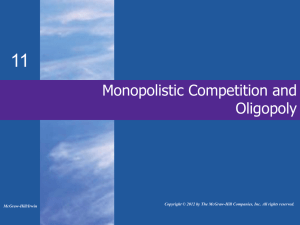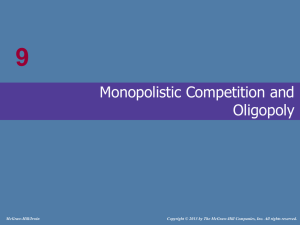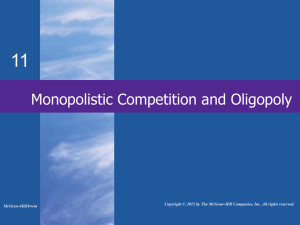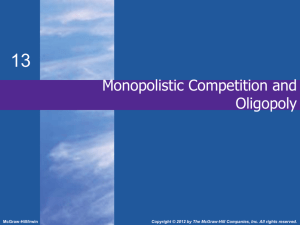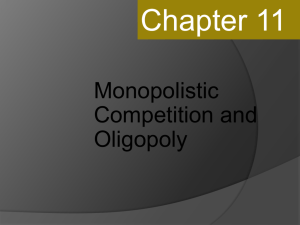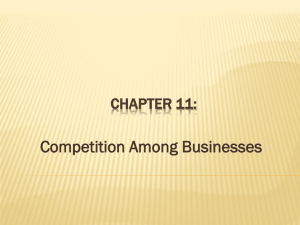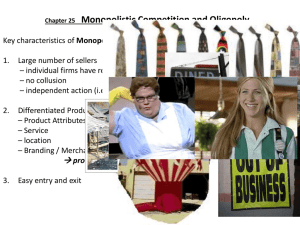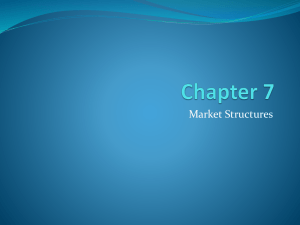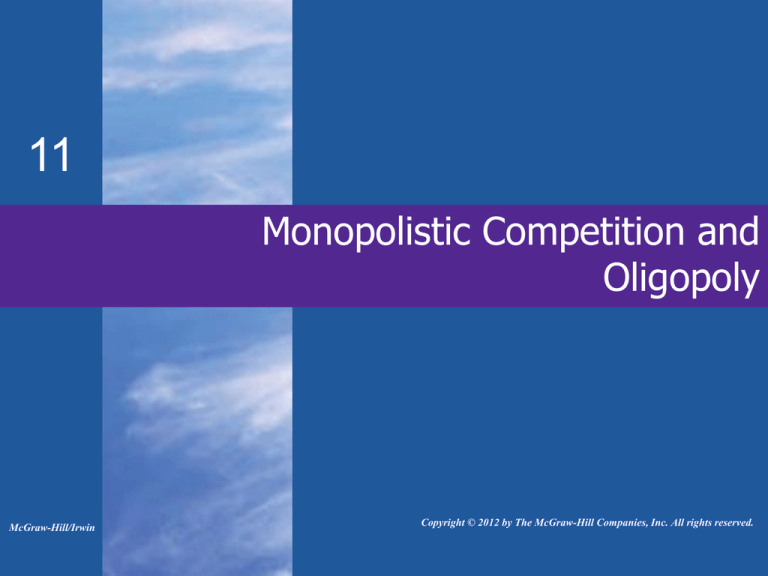
11
Monopolistic Competition and
Oligopoly
McGraw-Hill/Irwin
Copyright © 2012 by The McGraw-Hill Companies, Inc. All rights reserved.
Monopolistic Competition
• Relatively large number of sellers
• Differentiated products
• Easy entry and exit
• Advertising
LO1
11-2
Monopolistically Competitive
• Industry concentration
• Measured by:
• Four-firm concentration ratios
• Percentage of 4 largest firms
4-Firm CR =
Output of four largest firms
Total output in the industry
• Herfindahl index
• Sum of squared market shares
HI = (%S1)2 + (%S2)2 + (%S3)2 + …. +
(%Sn)2
LO1
11-3
Low Concentration Industries
(1)
Industry
(2)
4-Firm
Concentration
Ratio
(3)
Herfindahl
Index
(1)
Industry
(2)
4-Firm
Concentration
Ratio
(3)
Herfindahl
Index
14
114
Asphalt paving
25
207
Metal windows and
doors
Plastic pipe
24
262
Women’s dresses
13
84
Textile bags
24
263
Ready mix concrete
11
63
Bolts, nuts, and
rivets
24
205
Wood trusses
10
50
Plastic bags
23
240
Stone products
10
59
Quick printing
22
319
Metal stamping
8
31
Textile machinery
20
206
Wood pallets
7
24
Sawmills
18
117
Sheet metal work
6
25
Jewelry
16
117
Signs
5
19
Curtains and
draperies
16
111
Retail bakeries
4
7
LO1
11-4
Price and Output in Monopolistic Comp
• Demand is highly elastic
• Short run profit or loss
• Produce where MR=MC
• Long run normal profit
• Entry and exit
• Inefficient
• Product variety
LO2
11-5
The Short Run: Profit or Loss
Price and Costs
MC
ATC
P1
A1
Economic
Profit
D1
MR = MC
MR
0
Q1
Quantity
LO2
11-6
The Short Run: Profit or Loss
Price and Costs
MC
ATC
A2
P2
Loss
D2
MR = MC
MR
0
Q2
Quantity
LO2
11-7
The Long Run: Only a Normal Profit
MC
Price and Costs
ATC
P3= A3
D3
MR = MC
MR
0
Q3
Quantity
LO2
11-8
Monopolistic Competition: Efficiency
• Inefficient
• Productive inefficiency
• P > ATC
• Allocative inefficiency
• P > MC
LO2
11-9
Monopolistic Competition: Efficiency
P=MC=Min ATC for pure competition (recall)
Price and Costs
MC
ATC
P3= A3
P4
Price is Lower
D3
MR = MC
Excess Capacity at
Minimum ATC
0
Q3
MR
Q4
Quantity
Monopolistic competition is not efficient
LO2
11-10
Product Variety
• The firm constantly manages price,
•
LO2
product, and advertising.
• Better product differentiation
• Better advertising
The consumer benefits by greater
array of choices and better products.
• Types and Styles
• Brands and Quality
11-11
Oligopoly
• A few large producers
• Homogeneous or differentiated
•
•
•
LO3
products
Limited control over price
• Mutual interdependence
• Strategic behavior
Entry barriers
Mergers
11-12
Oligopolistic Industries
• Four-firm concentration ratio
• 40% or more to be oligopoly
• Shortcomings
• Localized markets
• Inter-industry competition
• World price
• Dominant firms
LO3
11-13
High Concentration Industries
(1)
Industry
Primary copper
(2)
4-Firm
Concentration
Ratio
(3)
Herfindahl
Index
99
ND
(1)
Industry
(2)
4-Firm
Concentration
Ratio
(3)
Herfindahl
Index
Petrochemicals
85
2662
83
1901
Cane sugar refining
99
ND
Small arms
ammunition
Cigarettes
95
ND
Motor vehicles
81
2321
80
2515
Household laundry
equipment
93
ND
Men’s slacks and
jeans
Beer
91
ND
Aircraft
81
ND
Electric light bulbs
89
2582
Breakfast cereals
78
2521
78
2096
Glass containers
88
2582
Household vacuum
cleaners
Turbines and
generators
88
ND
Phosphate fertilizers
78
1853
Tires
77
1807
Electronic
computers
76
Alcohol distilleries
71
Household
refrigerators and
freezers
85
1986
Primary aluminum
85
ND
LO1
2662
1609
11-14
Game Theory Overview
• Oligopolies display strategic pricing
behavior
• Mutual interdependence
• Collusion
• Incentive to cheat
• Prisoner’s dilemma
LO4
11-15
Game Theory Overview
RareAir’s Price Strategy
LO4
High
Uptown’s Price Strategy
• 2 competitors
• 2 price
strategies
• Each strategy
has a payoff
matrix
• Greatest
combined
profit
• Independent
actions
stimulate a
response
A
$12
Low
B
$15
High
$12
C
$6
$6
D
$8
Low
$15
$8
11-16
Game Theory Overview
RareAir’s Price Strategy
LO4
High
Uptown’s Price Strategy
• Independently
lowered prices in
expectation of
greater profit
leads to worst
combined
outcome
• Eventually low
outcomes make
firms return to
higher prices.
A
$12
Low
B
$15
High
$12
C
$6
$6
D
$8
Low
$15
$8
11-17
3 Oligopoly Models
• Kinked Demand Curve
• Collusive Pricing
• Price Leadership
• Reasons for 3 models
• Diversity of oligopolies
• Complications of interdependence
LO5
11-18
Kinked-Demand Theory
• Noncollusive oligopoly
• Uncertainty about rivals reactions
• Rivals match any price change
• Rivals ignore any price change
• Assume combined strategy
• Match price reductions
• Ignore price increases
LO5
11-19
Kinked Demand Curve
e
P0
f
D2
Rivals Match g
Price Decrease
0
LO5
Q0
MR1
Quantity
MR2
Price and Costs
Price
Rivals Ignore
Price Increase
MC1
D2
P0
e
MR2
f
MC2
g
D1
D1
0
Q0
MR1
Quantity
11-20
Kinked Demand Curve
• Criticisms
• Explains inflexibility, not price
• Prices are not that rigid
• Price wars
LO6
11-21
Cartels and Other Collusion
Price and Costs
MC
P0
ATC
A0
MR=MC
Economic
Profit
Q0
LO6
D
MR
Quantity
11-22
Global Perspective
LO6
11-23
Overt Collusion
• Cartels - a group of firms or nations
•
•
LO6
that collude
• Formally agreeing to the price
• Sets output levels for members
Collusion is illegal in the United
States
OPEC
11-24
Obstacles to Collusion
• Demand and cost differences
• Number of firms
• Cheating
• Recession
• New entrants
• Legal obstacles
LO6
11-25
Price Leadership Model
• Price Leadership
• Dominant firm initiates price
•
•
LO6
changes
• Other firms follow the leader
Use limit pricing to block entry of new
firms
Possible price war
11-26
Oligopoly and Advertising
• Prevalent to compete with product
development and advertising
• Less easily duplicated than a price
change
• Financially able to advertise
LO7
11-27
Positive Effects of Advertising
• Low-cost way of providing information
•
•
•
LO7
to consumers
Enhances competition
Speeds up technological progress
Can help firms obtain economies of
scale
11-28
Oligopoly and Advertising
The Largest U.S. Advertisers, 2008
Company
Advertising Spending
Millions of $
Procter & Gamble
$4831
Verizon
$3700
AT&T
$3073
General Motors
$2901
Johnson & Johnson
$2529
Unilever
$2423
Walt Disney
$2218
Time Warner
$2208
General Electric
$2019
Sears
$1865
Source: Advertising Age http://www.adage.com
LO7
11-29
Negative Effects of Advertising
• Can be manipulative
• Contains misleading claims that
•
LO7
confuse consumers
Consumers pay high prices for a
good while forgoing a better, lower
priced, unadvertised version of the
product.
11-30
Global Perspective
LO7
11-31
Oligopoly and Efficiency
• Oligopolies are inefficient
• Productively inefficient P > minATC
• Allocatively inefficient P > MC
• Qualifications
• Increased foreign competition
• Limit pricing
• Technological advance
LO7
11-32
Oligopoly in the Beer Industry
• The beer industry is now an oligopoly.
• Changes in demand
• Change in tastes
• Consumed at home and mass
•
produced
Changes in supply
• Technological advance
• Economies of scale
11-33

